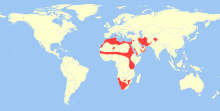You can help expand this article with text translated from the corresponding article in Romanian. (May 2022) Click for important translation instructions.
|
| This article needs additional citations for verification. Please help improve this article by adding citations to reliable sources. Unsourced material may be challenged and removed. Find sources: "Cape hare" – news · newspapers · books · scholar · JSTOR (November 2019) (Learn how and when to remove this message) |
| Cape hare | |
|---|---|

| |
| Conservation status | |
 Least Concern (IUCN 3.1) | |
| Scientific classification | |
| Domain: | Eukaryota |
| Kingdom: | Animalia |
| Phylum: | Chordata |
| Class: | Mammalia |
| Order: | Lagomorpha |
| Family: | Leporidae |
| Genus: | Lepus |
| Species: | L. capensis |
| Binomial name | |
| Lepus capensis Linnaeus, 1758 | |

| |
| Geographic range | |
| Cape hare in hieroglyphs | |||
|---|---|---|---|
wn "Cape/desert hare" in Ancient Egyptian hieroglyphs | |||
The Cape hare (Lepus capensis), also called the brown hare and the desert hare, is a hare native to Africa and Arabia extending into India.
Taxonomy
The Cape hare was one of the many mammal species originally described by Carl Linnaeus in his landmark 1758 10th edition of Systema Naturae, where it was given the binomial name of Lepus capensis.
The taxon is part of a species complex. Lepus tolai and Lepus tibetanus were moved out based on geographic distribution and molecular characteristics. The current remaining grouping of Lepus capensis sensu lato remains paraphyletic.
Description
The Cape hare is a typical hare, with well-developed legs for leaping and running, and large eyes and ears to look for threats from its environment. Usually, a white ring surrounds the eye. It has a fine, soft coat which varies in colour from light brown to reddish to sandy grey. Unusually among mammals, the female is larger than the male, an example of sexual dimorphism.
Distribution and habitat
The Cape hare inhabits macchia-type vegetation, grassland, bushveld, the Sahara Desert and semi-desert areas. It is also common in parts of the Ethiopian highlands, such as Degua Tembien.
Feeding

The Cape hare is a nocturnal herbivore, feeding on grass and various shrubs. Coprophagy, the consumption of an organism's own fecal material to double the amount of time food spends in the digestive tract, is a common behaviour amongst rabbits and hares. This habit allows the animal to extract the maximum nourishment from its diet, and microbes present in the pellets also provide nutrients.
Like other hares, they run fast. The only predator which is capable of outrunning them is the cheetah. All other predators are ambush and/or opportunistic hunters; examples of these are leopards, caracals, and black-backed jackals.
Breeding
After a 42-day-long pregnancy, the female gives birth to from one to three young, termed leverets, per litter and may have as many as 4 litters per year. A characteristic of hares which differentiates them from rabbits is that the young are born precocial; that is, the young are born with eyes open and are able to move about shortly after birth. The Cape hare is no exception in this regard.
Gallery
-
 Cape hare (Lepus capensis arabicus) photographed at Watba Camel Race Track, Abu Dhabi, United Arab Emirates
Cape hare (Lepus capensis arabicus) photographed at Watba Camel Race Track, Abu Dhabi, United Arab Emirates
-
Cape hare hieroglyph depicted at the Temple of Edfu
Relationship with humans
An example of an ancient Egyptian mummified Lepus capensis has been recorded in a tomb near Dendera. The egyptian god Wenet was a cape hare.
Taxonomy
Currently, 12 subspecies are recognised:
- Lepus capensis capensis
- Lepus capensis aquilo
- Lepus capensis carpi
- Lepus capensis granti
- Lepus capensis aegyptius
- Lepus capensis hawkeri
- Lepus capensis isabellinus
- Lepus capensis sinaiticus
- Lepus capensis arabicus
- Lepus capensis atlanticus
- Lepus capensis whitakeri
- Lepus capensis schlumbergi
References
- ^ Johnston, C.H.; Robinson, T.J.; Child, M.F.; Relton, C. (2019). "Lepus capensis". IUCN Red List of Threatened Species. 2019: e.T41277A45186750. doi:10.2305/IUCN.UK.2019-1.RLTS.T41277A45186750.en. Retrieved 19 November 2021.
- Linnaeus, Carl (1758). Systema Naturae per Regna Tria Naturae, Secundum Classes, Ordines, Genera, Species, cum Characteribus, Differentiis, Synonymis, Locis (in Latin). Vol. I (10th revised ed.). Holmiae: (Laurentii Salvii). p. 58 – via The Internet Archive.
- Lado, S; Alves, PC; Islam, MZ; Brito, JC; Melo-Ferreira, J (November 2019). "The evolutionary history of the Cape hare (Lepus capensis sensu lato): insights for systematics and biogeography". Heredity. 123 (5): 634–646. doi:10.1038/s41437-019-0229-8. PMC 6972951. PMID 31073237.
- Aerts, R. (2019). "Forest and woodland vegetation in the highlands of Dogu'a Tembien". In Nyssen J.; Jacob, M.; Frankl, A. (eds.). Geo-trekking in Ethiopia's Tropical Mountains: The Dogu'a Tembien District. Springer International Publishing. ISBN 9783030049546.
- Gautier, Achilles (2005). "Animal Mummies and Remains from the Necropolis of Elkab (Upper Egypt)". archaeofauna. 14: 139–170. Retrieved 25 December 2023.
- Hoffman, R.S.; Smith, A.T. (2005). "Order Lagomorpha". In Wilson, D.E.; Reeder, D.M (eds.). Mammal Species of the World: A Taxonomic and Geographic Reference (3rd ed.). Johns Hopkins University Press. pp. 196–197. ISBN 978-0-8018-8221-0. OCLC 62265494.
| Taxon identifiers | |
|---|---|
| Lepus capensis |
|